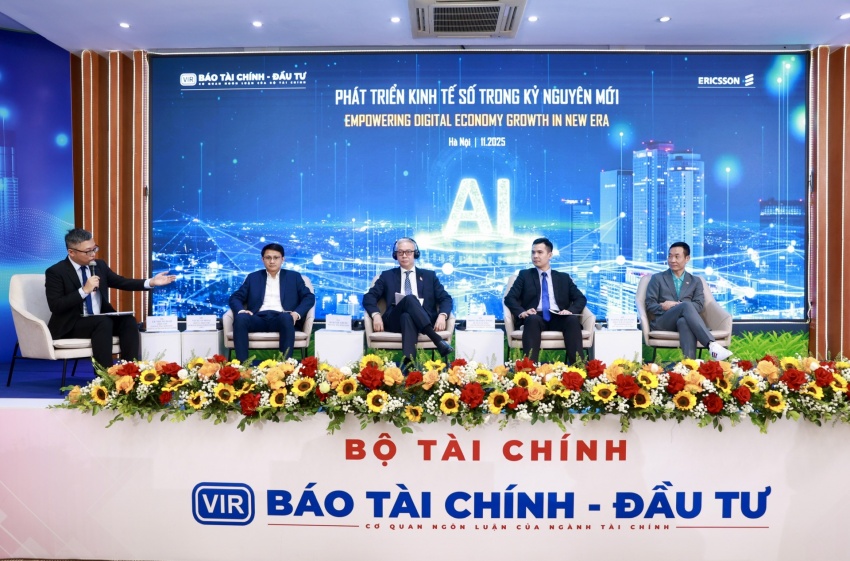These issues were at the centre of discussion at the "Empowering Digital Economy Growth in the New Era" conference held by VIR on November 25 in Hanoi.
 |
| The conference “Empowering Digital Economy Growth in the New Era” organised by VIR. Photo: Chi Cuong |
Vo Xuan Hoai, deputy director of the National Innovation Centre (NIC), stressed that 5G, and, in the near future, 6G and beyond, will be a strategic pillar for Vietnam alongside AI.
“The combination of 5G and AI offers significant advantages, reduced latency, smarter computation, and response times many times faster than before. It is a seamless fusion of hardware and software, accelerating technological development across sectors,” Hoai said.
He also noted that during the COVID-19 pandemic, the use of 5G and AI enabled effective remote medical consultation and treatment in remote areas. In energy, the management and operation of power systems and transmission grids now experience almost zero delay, while industries such as logistics are already deploying these technologies at scale.
“We have vast opportunities to harness and develop the combination of AI and 5G across Vietnam’s emerging technology sectors,” Hoai said.
According to the deputy director, Vietnam’s most urgent challenge lies in its technological infrastructure. While the country has made strong early progress in 5G deployment, continued investment is critical as AI evolves at an unprecedented pace.
“This rapid advancement will inevitably drive demand for more powerful networks, making upgrades to 5G, and eventually 6G, unavoidable,” Hoai said.
The second challenge, he noted, is talent. Cutting-edge technologies require highly skilled professionals, and Vietnam, like other ASEAN countries and the wider world, is competing fiercely for top-tier human capital. The recent selection of Vietnam by NVIDIA to host an AI research and development centre reflects global confidence in the country’s talent pool.
“In less than a year, the number of engineers at the centre has doubled. Some projects focus on AI-driven medical research, developing new drugs and saving significant time for pharmaceutical research centres worldwide. Yet, the demand for high-calibre professionals remains strong,” Hoai added.
Finally, he highlighted policy as the third challenge. Vietnam needs a clear regulatory sandbox, sufficient physical space, and flexible frameworks that allow new technologies to be tested and scaled locally.
Vuong Quan Ngoc, director of digital transformation at FPT Digital, also underscored the infrastructure challenge. Vietnam is targeting a $200 billion digital economy by 2030, up from roughly $45 billion, a goal he described as highly ambitious.
According to Ngoc, the foundations needed for 5G, 6G, and AI are still far from complete. The shortfall is not only in physical infrastructure, but also in the skilled workforce required to operate network and data systems. “With strong infrastructure investment, Vietnam could become a regional pioneer in Asia-Pacific and attract greater foreign investment,” Ngoc said.
He added that the effective convergence of the digital economy, AI, and 5G requires digital trust across three levels: government, business, and citizens. Only when all three pillars align can digital transactions contribute 30-40 per cent of GDP.
Dr. Dong Manh Cuong, head of the Business School at British University Vietnam, said the rapid growth of technologies such as blockchain, 5G, IoT, and digital payments is widening the talent gap.
Such roles, he explained, require individuals with knowledge spanning technology, business models, legal frameworks, and safety standards, capable of operating blockchain-based financial systems, optimising supply chains using real-time 5G and the Internet of Things (IoT) data, or developing new fintech solutions aligned with regulations.
“The biggest challenge for Vietnam is not a lack of talent overall, but the lack of people at the intersection of business and technology, those who can turn technology into productivity, efficiency, and real economic value for enterprises and for the national digital economy,” said Cuong.
From a Singaporean business viewpoint, Seck Yee Chung, vice president of the Singapore Chamber of Commerce Vietnam, noted that Singapore has long leveraged technology to drive growth. AI has been deployed in port operations to handle large cargo volumes without manual intervention, while regulatory sandboxes, such as those for autonomous vehicles, enable controlled innovation.
“Vietnam sits between China and Singapore. Singapore has a strict but flexible regulatory framework. China is a technology powerhouse with a very different approach to data governance. Vietnam is charting its own path, modernising its legal system rapidly and actively consulting businesses and experts,” Chung said. “The ultimate goal must be clarity, consistency, and balance, protecting citizens while promoting innovation and growth.”
Chung also referred to recent flooding in several Vietnamese provinces, noting that technology can strengthen climate resilience through smart agriculture, intelligent warning systems, and AI applications in the green and marine economies.
“Vietnam has many strengths, natural resources, a strategic location, and a young, dynamic population. With the right balance between regulation and innovation, investment in infrastructure and talent, and international cooperation, Vietnam is not only capable of keeping pace with the AI and 5G wave, but of leading in many fields,” he declared.

















































